Body armour - New materials, new systems Ian G. Crouch*
2019-07-16ArmourSolutionsTrenthamVictoria3458Australia
Armour Solutions, Trentham, Victoria, 3458, Australia
Keywords:Body armour Body armor Ceramic armour Reaction sintered silicon carbide UHMWPE Fibres Fabrics Strike-face materials Aramids Small-arms ammunition Hard armour plates Soft vests
A B S T R A C T This is a very timely review of body armour materials and systems since new test standards are currently being written, or reviewed, and new, innovative products released. Of greatest importance, however, is the recent evolution, and maturity, of the Ultra High Molecular Weight Polyethylene fibres enabling a completely new style of system to evolve - a stackable system of Hard Armour Plates. The science of body armour materials is quickly reviewed with emphasis upon current understanding of relevant energy-absorbing mechanisms in fibres, fabrics, polymeric laminates and ceramics. The trend in ongoing developments in ballistic fibres is then reviewed, analysed and future projections offered. Weaknesses in some of the ceramic grades are highlighted as is the value of using cladding materials to improve the robustness,and multi-strike performance,of Hard Armour Plates.Finally,with the drive for lighter, and therefore smaller, soft armour systems for military personnel the challenges for armour designers are reported, and the importance of the relative size of the Hard Armour Plate to the Soft Armour Insert is strongly emphasised.
1. Background
It is extremely timely for a review of body armour materials and systems for the following reasons:
(1) The National Institute of Justice, in the US, are currently in the final phase of revising their standard, with NIJ 0101.07[1],expected to be issued in 2019[2].This new standard will include guidance for testing of female body armour, and a radical step change in the range of small arms ammunition used to test future systems,as well as a significant relaxation of critical blunt trauma measurements.
(2) The UK Home Office has recently, in July 2017, issued a further revision of their body armour test standard [3].
(3) The latest in the series of Personal Armour Systems Symposia has recently been held in Washington D.C [4].
(4) The UK MOD is soon to appoint the preferred tenderer for VIRTUS, their completely new body armour system - an example of fit, form and function dominating evolution,especially in response to changes in the military operational environment [5].
(5) In Australia, Victoria Police have recently appointed ADA to supply 14,000 completely new ballistic vests in 2019 [6], -another example of fit,form and function dominating design,not new materials!
(6) And finally, as a warning to armour technologists keen on developing new body armour materials, the case against Second Chance,for selling defective vests in the early 2000s,has just been settled, after nearly twenty years [7]. These vests were constructed of a man-made fibre called Zylon which, whilst offering a very attractive set of initial properties, were found to environmentally degrade to the point where the vests seriously underperformed leading to tragic loss of life.
This review is also extremely timely because there has been a quantum shift in the market place in 2018.Armour solutions,based upon Ultra High Molecular Weight Polyethylene(UHMWPE), have now become the systems of choice for many police and miltary users, replacing the aramid-based solutions that have dominated the market for the past three decades or so.Even though UHMWPE armour materials have been available for the past forty years,since they were invented by DSM in The Netherlands in 1979, it is only now, in 2018, that developers and producers of this highperformance material can claim supremacy, and market acceptance [8,9].
This paper will therefore cover major advances in both fibres,and fabrics,as well as armour-grade ceramics.The main emphasis is placed upon protective materials for the torso but some mention will be made of new helmet technologies, as well as new, smarter uniform materials. Essential background reading to this review is contained within a recent publication covering the science of armour materials [10], especially Chapter 5 (Polymers and Fibre-Reinforced Plastics) [11], Chapter 6 (Fibres, textiles and protective apparel) [12], and Chapter 7 (Glasses and Ceramics) [13].
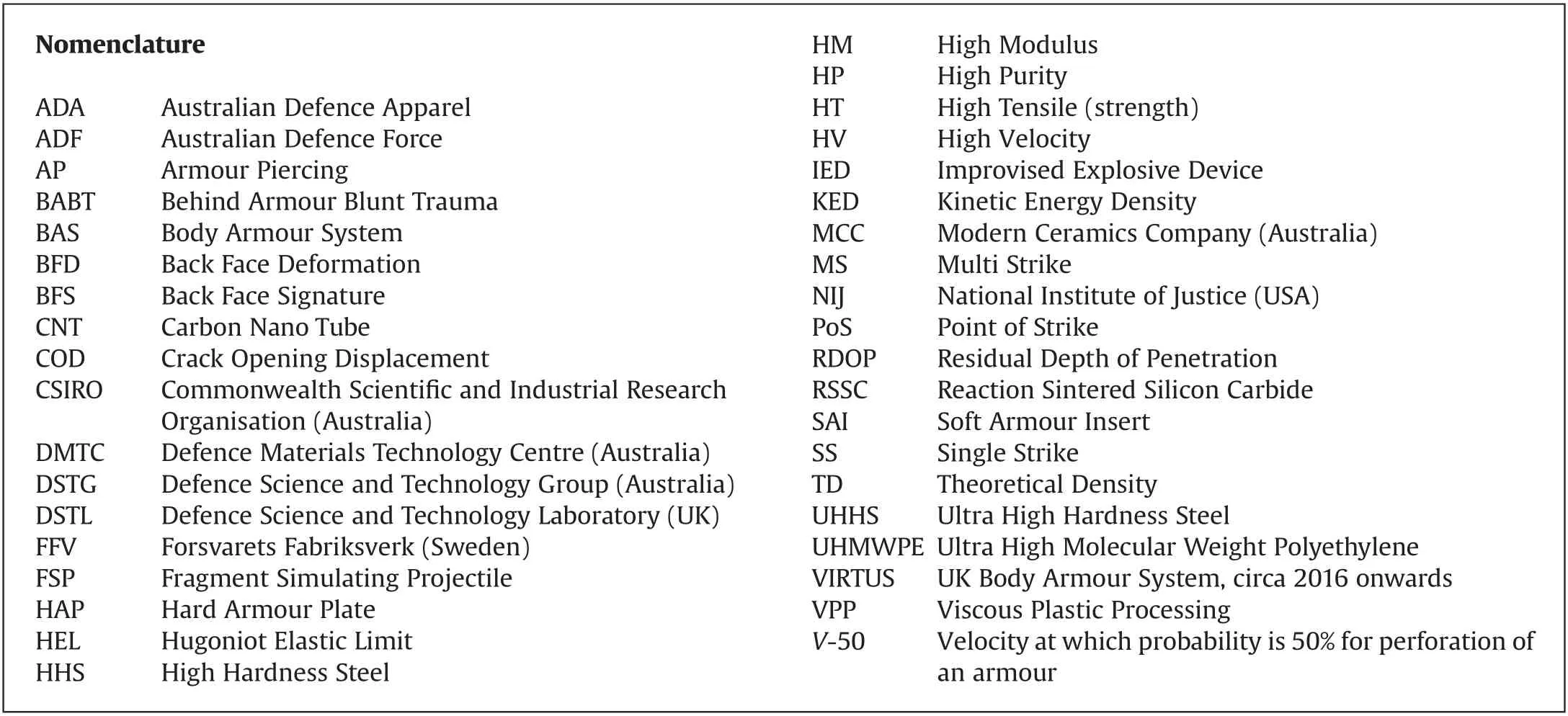
Nomenclature ADA Australian Defence Apparel ADF Australian Defence Force AP Armour Piercing BABT Behind Armour Blunt Trauma BAS Body Armour System BFD Back Face Deformation BFS Back Face Signature CNT Carbon Nano Tube COD Crack Opening Displacement CSIRO Commonwealth Scientific and Industrial Research Organisation (Australia)DMTC Defence Materials Technology Centre(Australia)DSTG Defence Science and Technology Group(Australia)DSTL Defence Science and Technology Laboratory(UK)FFV Forsvarets Fabriksverk (Sweden)FSP Fragment Simulating Projectile HAP Hard Armour Plate HEL Hugoniot Elastic Limit HHS High Hardness Steel HM High Modulus HP High Purity HT High Tensile (strength)HV High Velocity IED Improvised Explosive Device KED Kinetic Energy Density MCC Modern Ceramics Company (Australia)MS Multi Strike NIJ National Institute of Justice(USA)PoS Point of Strike RDOP Residual Depth of Penetration RSSC Reaction Sintered Silicon Carbide SAI Soft Armour Insert SS Single Strike TD Theoretical Density UHHS Ultra High Hardness Steel UHMWPE Ultra High Molecular Weight Polyethylene VIRTUS UK Body Armour System, circa 2016 onwards VPP Viscous Plastic Processing V-50 Velocity at which probability is 50%for perforation of an armour
2. Introduction
2.1. Basic description
The wearing of body armour is known to reduce fatalities in military environments [14]. It has also been very effective in reducing injuries and fatalities within the police force and correctional services. In an earlier review of some of the key issues [15],Horsfall describes some of the injury mechanisms associated with these attacks, and in a more recent historical review, Yadav et al.,[16] cover the evolution of body armour systems and introduce some futuristic material options.However,there is still a constant,and purposeful, drive to reduce the weight of such systems even further,as well as improve levels of comfort and fit.Cost reduction is also a commercial driver,especially when standard body armour systems can be priced as high as several thousand dollars per set.Each of these challenging requirements are being met through development of new materials, innovative designs and lighter weight systems. This paper reviews all important aspects of body armour and reports on the evolution of exciting new materials which are enabling new systems to come to market.
2.2. Fundamental principles
By definition,a ballistic impact is a dynamic event and is usually completed within 50-200μs.It is not too surprising,therefore,that effective, resistive responses by an armoured structure, including the armour material itself,need to occur within this timeframe.For example,mechanisms associated with novel auxetic structures[17]need to operate in a timely fashion in order to be effective,and the popular addition of shear thickening fluids to textiles[18]also need to possess the appropriate kinetic behaviour to be beneficial.Futhermore, with strain rates of up to 105s-1, any material whose elastic and/or plastic behaviour is time-dependent will also respond differently under ballistic impact conditions. The flow strength and tensile modulii of polymeric materials like the UHMWPE and aramid fibres are particularly sensitive to strain rate.The high strain rate testing of all armour materials is covered, in detail, elsewhere[19].
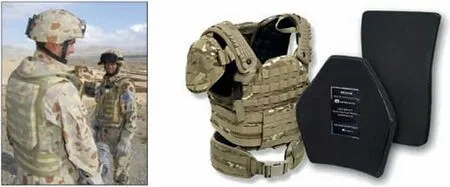
Fig.1. Images of miltary body armour systems.
All bullet-resistant, protective apparel is designed to arrest an attacking projectile without serious insult to the human body.This is achieved by various means and through the use of various conventional materials,depending upon the perceived threat.For hand gun bullets it is common practice to use a pack of layered fabrics,loosely held or stitched together to form a comfortable wrap around the torso.For knife and spike attack,additional,or different,packs are used which contain various “stiffer” materials like laminated fabrics, or metallic elements - a recent review covers this very important group of body armour materials [20] and testing techniques [21]. For high-velocity rifle rounds, including armourpiercing (AP) ammunition, a hard armour plate (HAP) is commonly added to the front of the system to work in conjunction with the soft armour pack and prevent perforation and serious blunt trauma (see Fig.1). These HAPs normally contain two basic families of materials:a strike-face which is designed to blunt,erode or shatter the incoming round,and a laminated,polymeric backing material which is designed to support the strike-face material,during initial impact, and then act as an efficient absorber, and arrestor,of the damaged projectile.Therefore there are three major groups of armour materials which require description, understanding and review: (a) formable, technical textiles, (b) fibrereinforced polymeric laminates, and (c) hard, brittle, strike face materials like ceramics and high hardness steels.Fig.2 shows these three elements, together with camouflage uniform material.
Material advances in armour systems are normally driven by the need for either a weight and/or cost reduction. But, as recently witnessed in operational theatres like Afganhistan, reduced coverage can also lead to significant weight reductions. And in more recent times, October 2018, the US Army started fielding a very lightweight, narrower system [22]. This highlights the conventional trade-off between weight, comfort and protection, and whilst this paper will naturally be covering the areal density(weight per unit area) and protection levels associated with advanced systems, it will not be covering comfort issues. Fit, form and function are very dependent upon operational roles and differ markedly between civilian and military theatres[23].Human factor studies, based upon anthropometric data, are a hugely important set of parallel activities and, in combination with advances in armour materials, lead to much improved, and comfortable, body armour systems. In recent years, more serious attention has rightfully been given to the needs of the female combatant and it is very clear that such studies [24], and methodologies, will lead to improved body armour systems generally.
2.3. Threats
The threats considered in this review are confined to small arms ammunition that range from 9 mm hand-gun bullets to 7.62 mm hard-cored, armour-piercing rounds. These are thoroughly reviewed in a recent publication [25], and only briefly discussed here. Images of selected rounds are shown in Fig. 3.
It is important to note that it is the core of the bullet that controls its penetration behaviour,not the calibre.The hardness of the core materials and the sharpness of the nose (blunt, ogival, or conical) will also affect the bullet's penetration capability. The effectiveness of each of these small arms rounds can be best appreciated, therefore, if one calculates a Kinetic Energy Density(KED)value based upon core dimensions,rather than calibre.This is the kinetic energy of the core,divided by the contact area projected onto the target. The data contained within Fig. 4, for example, has been calculated using the tip geometry of each of the respective cores, together with their respective muzzle velocities. The penetrative power of the tunsgten-carbide-cored, FFV round is quite clear.However, it should be noted that this particular round is not currently included in any military or civilian body armour threat spectrum although it is an established part of the threats covered by STANAG Level 3[26].It has,however,been used extensively for research purposes for the past decade or so and is included here for completeness.
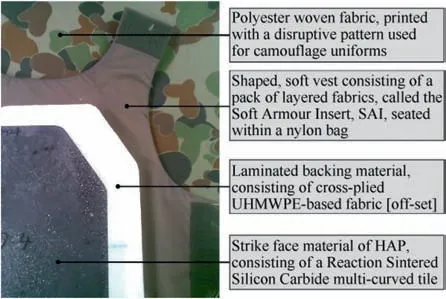
Fig. 2. Typical sub-systems and material groups used in a body armour system. Note that, for photographic purposes, the UHMWPE backing material has been off-set from the ceramic tile.
2.4. Energy-absorbing mechanisms
When designing advanced, lightweight body armour systems,and/or developing armour materials, the guiding principle is always to maximise energy absorbing mechanisms whilst designingout, or minimising, low energy failure mechanisms [27]. This fundamental approach to design is based upon a thorough understanding of the science of armour materials. In this following section,the reader is reminded,therefore,of the conventional energyabsorbing mechanisms already identified during ballistic impact of body armour materials and systems.
In soft,textile-based armour systems,there are two deformation processes involved, as illustrated in Fig. 5:
(1) The formation of a cruciform of stretched fibres, pulling-in material from the whole “width” of the soft armour pack -this mechanism introduces a size-effect in Soft Armour Inserts (SAIs) - see Sections 4.1 and 4.2.
(2) Out-of-plane deformation around the Point-of-Strike (POS)- the extent of this z-movement will control the Back Face Signature/Deformation and the degree of behind-armour blunt trauma (BABT).
In terms of energy absorbing mechanisms, Cunniff [29] identified two major contributors: the first relates to the strain wave velocity in the fibres,V;the second relates to the Work Done by the fibres as they are stretched,defined as the Elastic Stored Energy,Es.These two terms are defined by the following two equations

where V=strain wave energy, E=elastic modulus of the fibre,ρ=the bulk density of the fibre, ES=elastic stored energy in the fibre, and σ and ε are the stress and strain values up to the yield stress of the fibre. Following the pioneering work of Cunniff, an extended examination of these influential parameters has recently been published by Guo et al. [30].
With fibre-reinforced plastics, and therefore in laminated backing materials for HAPs, the energy-absorbing mechanims and failure modes have very recently been reviewed [12], and can be collated into two main areas:
(1) The dynamic, through-thickness, compressive strength and modulii of the laminate, during the initial phase of the penetration behaviour
(2) Membrane stretching of the rear fibres and plies of fabric,in the arresting,final phase of the penetration process.It should be noted that delamination,an interlaminar fracture process,does not, in itself, absorb much energy (it is a fracture process) - it just allows the separated plies to stretch and deform.
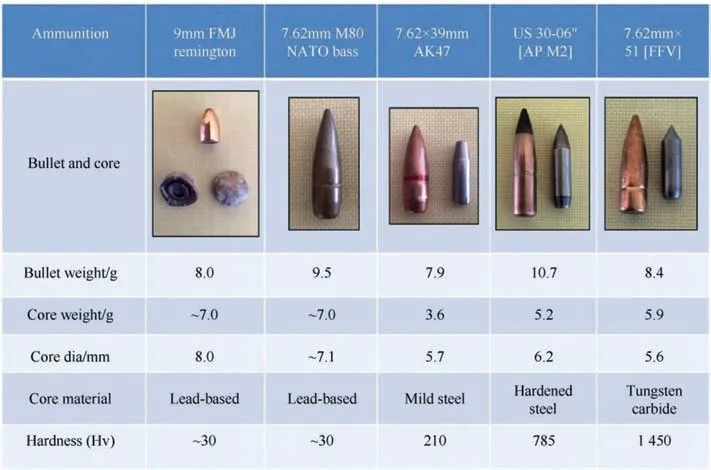
Fig. 3. Schematic table of selected small arms ammunition.
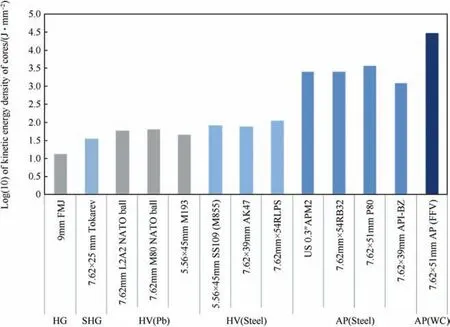
Fig. 4. Kinetic Energy Density values for the cores of selected small arms ammuntion.
For brittle,strike face materials,Crouch and co-workers recently reported the range of energy-absorbing mechanisms involved during a typical ballistic impact and listed the step-wise failure mechanisms that occur during the penetration process [13].These are captured by the x-ray image shown in Fig.6.Conoidal fracture is absolutely essential if a strike face material is going to be effective.On the other hand, radial cracking is a secondary event and circumferential cracking a tertiary event - both absorb minimal impact energy (being fracture processes) and contribute little to impact energy absorption.Their formation and presence,however,is very important when designing mult-hit HAPs-these issues will be discussed in Section 4. So, for ceramic materials there are two highly influential material properties - both of which govern its ballistic properties:
(1) Dynamic, through-thickness compressive strength (i.e. dynamic hardness).
(2) The stiffness of the material(a combination of the materials elastic modulii, its sectional modulii, and the support conditions confered on the ceramic).
After decades of research investigating relationships between the mechanical and ballistic properties of ceramics, the one singular material parameter that is found, consistently, to be strongly related to ballistic performance is the simple indentation hardness measurement. This fundamental relationship was, once again,confirmed in the latest research carried out by DSTL in the UK when studying the penetration behaviour of spark plasma sintered boron carbide [32]. At this juncture, it should be emphasised that whilst the fracture toughness of ceramics has an influence upon the cracking behaviour of a HAP, it does not significantly affect its ballistic performance. Research aimed at improving fracture toughness of brittle materials is therefore ill-founded if the motivation is simply to improve the penetration resistance of an armour material.
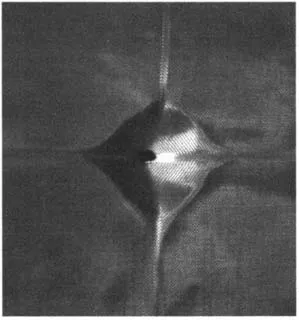
Fig.5. Photographic evidence of physical damage to a single ply of aramid fabric when impacted by a high velocity steel fragment [28].
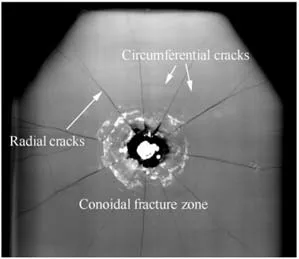
Fig. 6. High resolution x-radiograph of an impacted HAP showing damage from a 7.62 mm APM2 round. Note the symmetry of the field of damage, with the arrested round captured in the centre of the conoidal fracture zone, as well as radial cracks extending to the edge of the plate, and circumferential bending cracks [31].
3. Material developments
3.1. Fibres
One of the most noteworthy and significant advances in body armour materials in the past 20 years has been the evolution, and extended development, of the Ultra-High Molecular Weight Poly-Ethylene (UHMWPE) fibres and fabrics. In the early days of development, in the 1980s, they were an excellent ballistic material,especially against high-velocity fragments, but an extremely poor structural material. About ten years ago, the structural properties had been improved sufficiently to consider manufactuing combat helmet shells from this material[12,33].However,whilst this field of application has not quite matured yet, within the global marketplace, the ballistic properties of this family of fibres continues to advance,and set new standards.In a laminated form,they are now able to arrest a mild-steel-cored, 7.62 mm, highvelocity bullet at point blank range - a feat that few thought was ever possible.
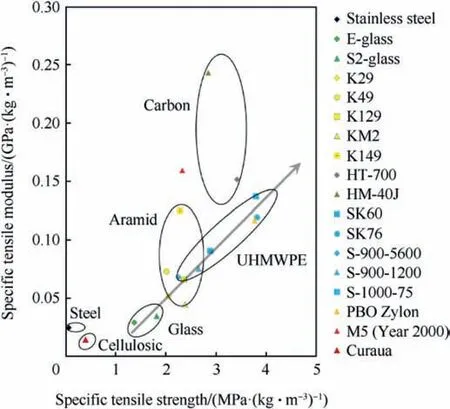
Fig.7. Relationship between specific tensile modulus and specific tensile strength of a broad range of both structural and ballistic fibres.
In 1991 [34], Pervorsek first published a diagram showing the relationship between the specific tensile modulus of ballistic fibres and their tenacity.Based upon this work,and an earlier publication[12], Crouch has recently updated this important relationship by including data for newly-developed fibres, including the family of natural fibres-see Fig.7.The upward trend for the ballistic fibres(glass,aramid and UHMWPE)is very clear and shows that the most recently developed variants of UHMWPE have now surpassed the values for Zylon,a PBO fibre claimed in the 2000s to be the“fibre of the future”. It is also clear from this new diagram that the more structural fibres, like K149, the steels, and the carbon fibres(especially the HM variants)lie consistently above the trend line for the ballistic fibres. It also confirms that the “goal” data, originally laid down for the development of the M5 fibre, was probably erroneously set! The data point for HT-700 carbon fibre suggests that these HT variants might be the most suitable in hybrid laminates designed to cope with both structural loads and ballistic impacts. At the bottom end of this trend line, lies the family of natural fibres, like curaua, a plant fibre from South America. From their measured properties [35], it is clear from this diagram, that the natural fibres will never become high-performance fibres but,as the latest research states [36], they do benefit from being environmentally friendly and low cost.
Both strength and modulus values are important-not one,but an optimised balance of both parameters. Using the data for the ballistic fibres,as indicated by the trend line in Fig.7,one can assign a power law relationship between the two which has an R2value of 0.86.

Since Fig.7 is a plot of specific values,and with reference back to Equations (1) and (2),


In other words, a high value of wave velocity(sonic velocity) is essential, as is the work done in physically stretching the fibres, if the ballistic performance of these fibres is to be maximised.Further improvements in any ballistic fibre,therefore,would be expected to sit close to this trend line as described by Equation(3).Time will tell whether this relationship is valid.
In recent work published by Harm van der Werff and colleagues at DSM[37],the authors claim that the strength of such fibres may never be bettered. Supported by some excellent work from researchers at the Ernst Mach Institute in Germany, they argue that amongst all of the leading fibres, including the sp2family of graphenes and carbon nanotubes, it is the UHMWPE fibres that show maximum potential, achieving about 44% of their theoretical strength. However, no mention was made of tensile modulus which, as this review paper has shown, is equally important as tensile strength.The dynamic modulus and strain wave velocity of fibres can also be measured very easily, as presented by Menghe Miao of the CSIRO, Australia [38], and should be used more regularly to measure sonic velocities in yarns,and tows,as well as single fibres.
3.2. Fabrics
It is normal, and conventional, practice for body armour designers to use multiple layers of dry fabric, like a woven aramid fabric. However, some researchers have investigated the effects of adding an elastomeric matrix to the fabrics. Gopinath [39], for example, showed that such additions can reduce the maximum deflection of the armour but increased the deformed area. However, the mass efficiency of the soft armours, with and without a matrix, was not calculated. Earlier work in this area has regularly shown that there is little to be gained,ballistically,in using a matrix material for soft armour applications.
Woven fabrics are still very popular for soft vests because they conform extremely well and provide maximum levels of comfort.They are however, not very efficient, ballistically [11], since by design most of the fibres/tows/yarns are not straight. Recognising this fact, the global producers like DuPont, Honeywell and DSM,have been developing fabrics using unidirectional fibres. DuPont produce an elegant, stitched, non-crimp, aramid fabric, whilst the UHMWPE producers have focused upon manufacturing plies of fibre-reinforced, thermoplastic films. In both cases, the finished fabrics consist of either two or four cross-plied layers.These layers are then normally stitched,as in the case of dry,aramid fabrics,or tack-bonded, as with the range of the thermoplastic UHMWPE preimpregnated fabrics.Crouch et al.[11]cover the general effects of stitching and quilting, and, whilst some researchers, like Carr[40],report likely improvements in ballistic performance of quilted fabrics, others, like Abtew [41], only report expected findings. For example, decreases in formabilty and draw-in with an increase in the stitch density of the quilting.
Over the past two decades, it has become very popular to research the benefits of adding shear thickening fluids, either as fabric coatings or as discreet pockets of fluid [11,42-45], as highlighted in a recent review of soft body armours by Arora and Ghosh[18]. However, in another study by Gurgen et al., [46], whilst application of STFs,applied as a coating,was found to be beneficial,they determined that the advantages were not driven by any shear thickening effect - instead, they identified that the STFs were responsible for simply increasing the inter-fibre friction which enhanced fibre-yarn coupling, spreading the impact load over a greater area thus reducing the penetration depth.This suggests that any claimed benefits of shear-thickening fluids require deeper scrutiny. However, most researchers, like those researching the effects upon 3D structures [47] still believe that there are enhancements to be gained.
One further group of fabrics has been receiving more attention recently - knitted fabrics. These fabrics have poor structural properties but, when impacted, they do demonstrate very large out-of-plane deformations. This has perceived benefits when looking to improve wound ballistics by capturing small fragments,and soil particles, from Improvised Explosive Devices (IEDs) thus reducing the need for multiple operations and improving healing times.Recent modelling work at ARL[48],is looking to optimise the knit architecture and thereby ballistic performance of these fabrics.If successful,knitted fabrics could replace the very fine,woven silk fabrics that have been reportedly used in groin protective wear[49].
Advances in fabric technologies are not restricted just to the ultra-lightweight fabrics used for backing materials. Ashok Bhatnagar and his team at Honeywell have developed a new range of hybrid fabrics for use in load carriage equipment [50] and claim that up to 40% saving in weight can come from the use of a laminated hybrid fabric combining UHMWPE fibre-reinforced films with thin, low denier CORDURA fabrics. The authors reported that the weight-saving laminates can also be laser cut to a more precise shape compared to conventional webbing attachments.
3.3. Strike-face materials
Even with the advent of ultra-lightweight laminates based upon UHMWPE,with their remarkable ability to arrest some of the mildsteel-cored ammunition,ceramics remain the most important and influencial group of armour materials because they are very effective against hard-cored, armour-piercing ammunition. This is because for glasses and ceramics, the hardness of the strike-face material by and large governs its ballistic performance. High hardness steels (HHS), like AR500 [51], and most recently Ultra High Hardness steels(UHHS),like Armox Advance from SSAB,have been a popular stand-alone HAP for decades,and still represent the lowest cost option. Advances in metallurgical practices have enabled thinner and thinner products to be produced.However,on a weight-for-weight basis, they do not compete very favourably with the ceramic grades - see Table 1.
For body armour applications, three main grades have established themselves in the market place: high-purity aluminas, silicon carbides and boron carbides,increasing in ballistic merit rating,and price, in that ascending order.
Nowadays,little attention is being given to the well-established families of aluminas whilst the glass-ceramics continue to play only a small part in body armour systems.This latter family has recently been thoroughly reviewed by Benetez and co-workers from Brazil and Germany [54] since they offer great potential for transparant armours.The family of silicon carbides are also well established and the hot-pressed, SiC-N variant (see Table 1) still represents the ceramic of choice, in tile form, for many vehicular systems. However, for body armour applications, Reaction Sintered Silicon Carbide (RSSC) grades have become more popular because of their ability to be near-net shaped and,over the past 15 years or so,both US and Australian-made HAPs, incorporating this material, have been fielded.In support of such acquisitions,these inherently more defective grades have been extensively researched, new quality control procedures adopted, and improved NDI techniques developed,[53].A wide variety of siliconized silicon carbide grades,like Silit®SKDH, are now available through suppliers like St. Gobain,[55].
For most ballistic applications, boron carbide remains the ultimate armour material of choice - it is one of the hardest ceramic materials (see Table 1), falling just short of diamond and cubic boron nitride, and, because of its low density (~2,520 kg m-3), it has a very attractive set of specific properties for body armour systems [56]. Its structure, properties and stability under stress have recently been reviewed in a highly recommended paper by Domnich et al. [57].

Table 1Summary of important properties of a range of strike-face materials.
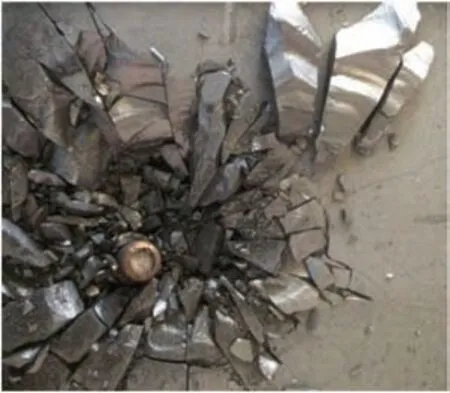
Fig. 8. VPP boron carbide impacted by a 7.62 mm tungsten carbide cored FFV round[58].
It is well known to armour technologists that boron carbide strike face materials behave in a more glass-like manner when impacted by high velocity rifle rounds, as compared with SiC and Al2O3materials - see Fig. 8. However, this does not affect their excellent ballistic performance except against some specific armour-piercing threats,like the tungsten carbide-cored FFV round(see Fig. 3). In previously unreported work by Crouch [58], boron carbide targets,using 10 mm thick VPP B4C tiles with an UHMWPE backing, in combination with a standard Soft Armour Insert,exhibited the following V5ovalues against three different 7.62 mm AP rounds: 949 m s-1against the APM2; 1,002 m s-1against the B32; but only 598 m s-1against the FFV round. This unexpected drop in ballistic performance was first identified by Colin Roberson,and others, in a landmark paper given at the “Cocoa Beach” conference in 2005[59],in which RDOP measurements were recorded for three different materials;AD99 alumina,sintered SiC,as well as a HP version of B4C - see Fig. 9. Against this specific threat, the RDOP measurements for B4C are very similar to the considerably less hard alumina targets.
This under-performance appears to be due to shear localization occurring within the material under shock loading.As reported by Volger in 2004 [60], the shear strength of boron carbide in the shocked state decreases rapidly above the HEL, indicating premature failure of the material as the shock stress reaches a threshold of ~20 GPa - but why is this? Current understanding of this premature failure mechanism is favouring the notion of a phase transformation although the proposition that it might be related to catastrophic propagation of microcracks is still mooted. Chen [61]had reported shock-induced localised amorphisation in boron carbide as early as 2003. Since then deeper understanding and prevention of this shear localization effect has been the subject of much research as typified in a 2016 paper by Subnash et al.,entitled“In search of amorphisation-resistant boron carbide” [62], and more recently through the work of Xie et al.,in 2017[63],and that of Parsard and Subnash [64].
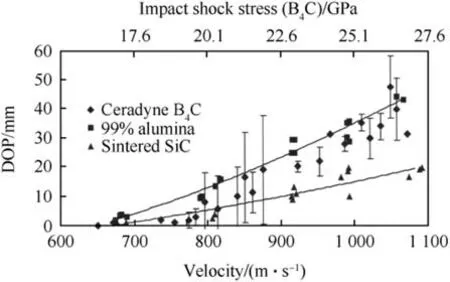
Fig. 9. RDOP data, into AA6082-T651, for impacts from FFV rounds against various 6 mm thick ceramic tiles [59].
Despite the absence of a deep understanding of the amorphisation issue,boron carbide continues to be used with confidence in high-end, weight-driven armour applications, but it does have several natural drawbacks: cost of manufacture and, like all ceramics, shapeability. These aspects have been addressed in a number of ways through the adoption of liquid phase sintering and pressureless sintering[13],or by utilising the reaction bonding(or sintering)process as reported by Chhillar in 2008[65],Karandikar in 2010 [66], and more lately, by Hayan [67]. However, the most exciting developments in recent years have been those that couple a shaping process with a pressureless sintering operation. Researchers at Georgia Institute of Technology, led by Robert Speyer,reported[68]success with the use of pre-formulated,dry powders being forged into final shapes, followed by pressureless sintering,and the Israeli researchers from Haifa filed a patent in 2005 [69],which relied upon similar technology. These works were followed by a relevant PhD thesis published in 2011, by Charles Wiley,entitled “Synergistic methods for production of high-strength and low cost boron carbide” [70]. However, one of the most successful advances in this field was led by the DMTC in the development,and full-scale commercialisation, of a unique shaping process (Viscous Plastic Processing,VPP),especially effective for thin boron carbide,armour-grade ceramics[71].
Improving the ballistic performance of ceramics through the addition of reinforcing particles has always attracted the attention of researchers.For example,in a very recent study Alexander et al.,[72],looked at the effects of adding graphene nano platelets(GNP)to boron carbide matrices. The addition of 2% (by volume) of GNP was found to improve bulk density by acting as a sintering aid but apart from a small increase in fracture toughness levels,there was a reported decrease in flexural strength - a common finding when working towards a ceramic matrix composite.
Others, over the past two decades, have focussed their development work on creating optimal blends of boron carbide and silicon carbide, using reaction bonding (sometimes called reaction sintering) techniques [67,73]. The resultant products possess bulk densities between 2,650 and 2,950 kg m-3(compared with typical values for boron carbide of 2,520 kg m-3and silicon carbide of 3,150 kg m-3).In a recent in-depth study by Williams[74],in 2015,compositions were varied between 20% and 80% (by weight) of boron carbide.Optimum ballistic perfomance was achieved with a boron carbide content of ~40%, coupled with Theoretical Density(TD)values of greater than 96.5%and the use of coarse B4C particles.In reaction bonded materials, residual silicon contents can be as low as 10% by weight thus maximising hardness values. Commercially available blends are available through Paxis (in Israel) and Precision Ceramics(in UK),to name but two.It is believed that such companies use a 40/60 blend of B4C/SiC to obtain optimum ballistic performance at an affordable price. This blending approach also circumvents any issues arising from amorphisation of the pure boron carbide grades-the author suspects that this may be one of the drivers for their development and recent adoption.
3.4. Backing materials
Ideally, backing materials need to be as rigid as possible and therefore metal-based systems are instinctively attractive. Unfortunately, they cannot be shaped very easily. Hence, mouldable,fibre-reinforced plastics are the obvious choice. Functionally, they also need to be very effective at arresting blunt projectiles,since the strike-face material will blunt the core of any bullet. Fibrereinforced plastics are exceptionally good at absorbing energy in this way, so polymer-based laminates are ideal as backing materials.Generally,the most effective backing materials are those that have the greatest ballistic efficiency against FSPs, and these are presently those based upon UHMWPE fibres, which is why many HAPs are manufactured using either Spectra®or Dyneema®products. They are expensive though, which is why the aramidreinforced plastics, and even glass-fibre reinforced thermosets,are still in use.
As the UHMWPE fibres and fabrics have been refined,the matrix material plays a significant part in their ballistic behaviour.Kraton was one of the first matrix materials used in 3rd generation UHMWPE products, but now the two main global suppliers offer two, totally different matrices. For example, Honeywell's SR5143 product, a 4-ply, cross-plied prepreg with an areal density of 163gsm, has a fairly compliant, rubber-like matrix, useful for BFScontrolled HAPs. In contrast, their SR5231 product, a 4-ply, crossplied prepreg with a mean areal density of 167gsm, has a PUbased matrix, which is a lot stiffer and is useful when HAP designs are limited by a critical perforation velocity. These represent 5th generation products and DSM provide a very similar set of diverse products for different applications, including those for use in the production of combat helmet shells.
UHMWPE backing laminates are produced by subjecting dry stacks of the prepregs to a time/temperature/pressure cycle,either in an autoclave, hydroclave or between heated, high-pressure platens. Choice of manufacturing route is critical and the pros and cons of these processes have recently been reviewed by Crouch et al.,[13].Processing temperatures are normally about 130-140°C,but the one strongly influential parameter that has emerged in the last ten years is consolidation pressure. Little can be found in the open literature but both leading suppliers recommend as high a pressure as possible on the basis that this improves ballistic performance. Whilst this may be true for monolithic laminates, the relationship may not carry over into the production of HAPs.Furthermore, the fundamental reason behind this has never been published, although verbal advice suggests that an increase in consolidation presssure leads to an increase in the in-plane flexural modulus of the laminate. This author goes one step further and suggests that if this is the case,then it is probably due to an increase in volume fraction of fibres, which is known to increase both inplane properties, and ballistic performance [12], - however, the scientific community awaits the evidence in the case of highly compressed UHMWPE products.
Alternative backing materials are constantly being developed/assessed because the UHMWPE stock material is a very expensive option, and often in short supply. In 2018, Benzait et al. [75] published a review of a range of polymer-matrix composites for body armor applications.This is a very broad-based review but focusses,almost exclusively, on futuristic materials like CNTs, graphene and natural fibres, without any reference to, or acknowledgement of,the critical properties required of a backing material, namely through-thickness, compressive strength, and modulus, and inplane tensile properties of the rear plies. What is very clear though is that use of a low volume fraction(30%)of a low strength,low modulus natural fibre, like curaua, is simply not going to be adequate as a stand-alone ballistic material - see Fig. 7. However,hybridisation may provide more scope.
The use of hybrid fabrics is not new to the armour technologist[11],especially when attempting to design a backing material with graded properties: combinations of carbon/aramid and aramid/UHMWPE fabrics are quite common - see recent published work by Bhatnagar and co-workers for some typical examples[50].This is also the approach taken by Ali and co-workers[76]who reported their attempts to integrate bamboo fibres into a conventional Eglass/polyester laminate for armour materials offering 9 mm handgun protection. The results were rather cursary and inconclusive - nevertheless, this is the necessary approach for natural fibres,I believe-integration through hybridisation,rather than by substitution.
3.5. Cladding materials
Second only in importance to the families of strike-face and backing materials, is the existence of cladding materials, which have grown in recognition over the past decade. The effects of cladding ceramic tiles with a layer,or layers,of polymeric materials have been investigated by a number of researchers.Early results of Nunn et al. [77] showed a significant improvement in the ballistic performance of ceramic armours based upon 100 mm square, single tiles of 6 mm boron carbide,against the 7.62 mm AP M61 round,when layers of UHMWPE were bonded onto the surface of the ceramic.This was in line with parallel work by Sarva et al.[78]who also showed that the ballistic efficiency of silicon carbide tiles,impacted with tungsten penetrators at ~900 m s-1, could also be enhanced through the use of E-glass/epoxy cladding layers. However, in more recent work by Crouch, Appleby-Thomas and Hazell[79], it was clearly demonstrated that, for single impacts of a 7.62 mm M43 (AK47) round, a cladding of aramid-fibre reinforced epoxy, bonded to the surface of thin boron carbide tiles, had no measurable effect upon penetration resistance.This latest view has been reinforced by some elegant work of Rhabek et al. [80] who demonstrated that there was no difference in the degree of core erosion of the M61 7.62 mm AP round against 98%alumina targets whether a cladding layer was present or not. Further research is quite clearly required in this area.
However,this lack of understanding is not the case with multistrike behaviour and ballistic performance. In 2014, Crouch et al.reported a detailed investigation into the effects that cladding has upon the ballistic performance of a series of tightly-controlled HAPs, constructed of 9 mm thick, silicon carbide tiles, and tested using the 7.62 mm APM2 round at a nominal velocity of 870 m s-1,[31]. They also investigated the effect that various cladding materials had upon radial crack formation,Crack Opening Displacement(COD),and ballistic resistance,as measured by Back Face Signature(BFS). What they found was that a cladding of aramid-fibre reinforced epoxy resulted in a lowering of the mean BFS values, and a reduction in Crack Opening Displacements(COD)but an increase in the number of radial cracks. Research continues in this area [81],especially to gain a complete understanding of the acceptance, or otherwise, of HAPs containing cracks. Table 2 illustrates how the presence of cracks has been shown to reduce the measured V-50 of a plate but that the degree of degradation depends upon the function, and therefore the design, of the HAP itself. As one might expect, multi-strike HAPs do not degrade as severely as HAPs designed to withstand just one strike.
In summary, for multi-strike HAPs, therefore, it would appear that the presence of an appropriate cladding layer does not improve the ballistic performance of the first strike but does improve multihit performance by ensuring that the cracks, emanating from the first strike, are kept as closed as possible. In future, therefore, the use of thin plies of 5th generation UHMWPE or nano-layers of ultrastrong fibres like the sheet-like graphenes,may prove beneficial,as cladding layers, since these materials possess very attractive inplane properties.
It should also be noted that cladding the ceramic increases the general robustness of the finished HAP. In fact, with the advent of stacked systems(see Section 5)the cladding/wrapping of backingfree, ceramic-only HAPs may well take on a more major role in future systems.
4. Design aspects
Before completing this review and discussing the evolution of body armour systems,it is necessary to recognise that a number of significant design issues have arisen from system development activities over the past decade.
For soft armours, these issues centre on coverage and shot location. As military vests have shrunk in size quite dramatically over the past ten years, the significance of edge performance and shot placement have started to take effect, and affect design. By example,consider the data shown in Fig.10.This is a standard set of ballistic testing data using 9 mm handgun ammunition, in accordance with NIJ 0101.06[82],against a series of soft vests of various sizes(Tiers).There are two things to notice;(i)that the BFS values for shot number six is significantly lower than for shots 1, 2 and 3(noting that shots 4 and 5 occur at 30°obliquity), and (ii) that for shot six in particular,there is a distinct decrease in mean value for BFS with a decrease in size of vest. These effects are discussed in detail elsewhere [11]. Suffice to say that because of these quantifiable edge effects, the effective coverage for soft vests decreases with size of vest and not simply because the vests are physically smaller. As proposed in a recent paper by Robinson and Horlick[83], there is a current need for a systematic, large-scale study to fully understand, and further quantify, these effects.
For hard armours,edge effects become even more complex and far more significant.It is well known that any armour product will not confer a perfect level of protection right up to the edge of that product,even for a free-standing piece of armour steel.What is not fully recognised yet is that the relative sizes of the HAP and the soft vest is crucial in dictating the ballistic performance of the system[84].Whilst little has been published in this area,the drive during the past decade to reduce the weight and therefore size of the vest,has had severe consequences upon performance and is now limiting design.Fig.11,taken from the work of Sandlin and Crouch[85], illustrates the point and introduces the following three terms:
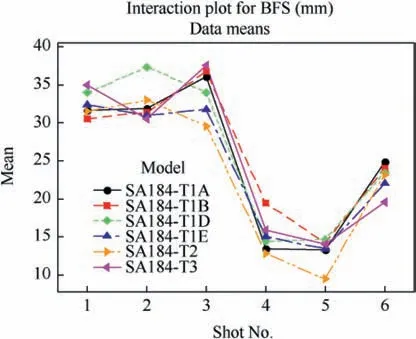
Fig.10. Variations in mean BFS values for UHMWPE-based soft vests,of different sizes,as a function of shot location.

Table 2Measured V-50 values as a function of strike number,for a triangular shot pattern,in which the distance between strikes from a 0.3”APM2 was recorded to be between 100 and 125 mm.
(1) Edge Distance, ED, the distance between the PoS and the edge of the HAP
(2) Overlap Length, OL, the distance between the edge of the HAP and the edge of the vest.
(3) Total Edge Distance, TED, the distance between the PoS and the edge of the vest,such that TED = ED + OL.
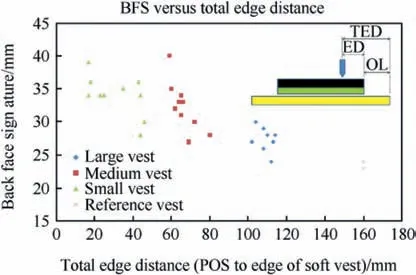
Fig.11. BFS values as a function of Total Edge Distance(TED)for a series of an impacts from a 0.3′′APM2 round against a multi-strike HAP supported by vests of different sizes.
It is quite clear from Fig.11 that BFS generally increases as TED decreases-an effect not previously reported.In this case,however,the effect was not overly significant because all BFS values were below the maximum allowable value of 44 mm. However, during development of a much lightweight plate, designed to take three strikes from a range of high-velocity 7.62 mm rounds, the effect started to dictate design. Fig.12, like Fig.11, shows a very obvious relationship between BFS values and the size of the soft vest.However,on this occasion,at small values of TED,the BFS values are well above the allowable maximum of 44 mm.At least they were at the time since this work was carried out circa 2010. With the advent of NIJ 0101.07 this maximum value will be relaxed such that some BFS values can be up to 50 mm.Furthermore,there are recent reports that the US Army are considering raising the maximum values to 58 mm[22].If this were the case,then the data presented in Fig. 12 would need to be revisited, and the beneficial consequences realised: greater effective coverage and/or much lighter weight HAPs.
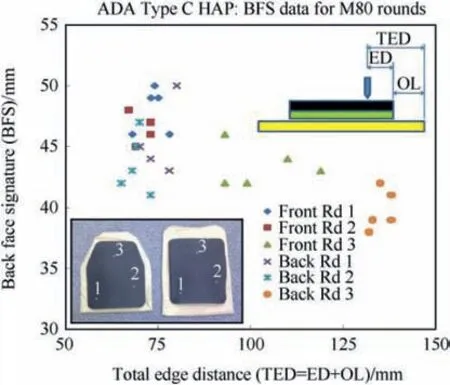
Fig.12. BFS values as a function of Total Edge Distance(TED)for a series of an impacts from a 7.62 mm M80 round against a multi-strike HAP supported by vests of different sizes.
5. Body armour systems, old and new
Over the past five decades, as covered in Fig.13, through all of the changing demands imposed by the different military and civilian theatres of operation,it is the design,form and function of the Hard Armour Plate that has seen most dramatic changes. And,even though these changes have been brought about by the constant drive for lighter and lighter systems, most of the material options are still available in the market place, even the heavier systems based upon high hardness steels.
In the 1970s, it was fairly common to simply use a lightly clad plate of high grade alumina positioned in front of the soft vest to offer protection against both lead-filled and armour-piercing variants of the 7.62 mm rounds.During the 1980s better designed,SiCcontaining plates became more popular with accompanying weight savings - armour designers recognised that the ceramic tiles behaved more efficiently if they were backed by a stiff, fibrereinforced polymer. However, during the period 2000-2010,body armour systems became more complex,more protective,and purchase specifications far more demanding with more and more multiple strikes defined.As a result,and as the red arrow shows in Fig. 13, the weight of these systems started to escalate, until the systems designed to stop the tunsgten carbide cored rounds were considered too heavy for some users.Then came a strategic shift in the need for HAPs and body armour systems generally - the conflict in Iraq was subsiding but the war in Afganhistan was heightening.Rather than big,bulky and fully protective systems that were required to patrol the streetscapes of Iraq, body armour systems needed to be lighter and smaller, enabling greater mobility for soldiers covering the ground in Afganhistan. From 2010 onwards,therefore,systems have become smaller and smaller,specifications less demanding and, as a consequence, weights began to fall through either specification changes,improved designs or through the use of boron carbide materials. The lowest of the three green arrows in Fig. 13 illustrates the weight saving that was possible when the number of required strikes was reduced from six to three.As systems have become smaller with the size of the HAP approaching, if not matching, the size of the soft vest,stand-alone systems have emerged, as illustrated by the top green arrow in Fig.13. Whilst this is a heavy example of a HAP designed to withstand multiple strikes from an AP round,the principle also applies at lower threat levels: stand-alone plates, if designed correctly,should be lighter in weight than a combination of a HAP and a SAI of the same size.
And finally, since 2015, the rapid development of highly compressed forms of UHMWPE UD fabrics has seen a dramatic reduction in the weight of body armour systems against both lead-filled and mild steel cored ammunition [37]. Refer to the blue arrow in Fig.13.This latest evolution in high performance armour materials has brought about a shift change in the form and function of HAPsstacked systems are now possible, and fielded.
In summary, therefore, Fig. 14 presents the full suite of body armour systems that are currently available to the designer and user. Modular systems, as represented by the Modular Combat Body Armour System (MCBAS) developed for the Australian military,have a fixed shape and a soft vest that provides near maximum coverage - these are very functional when carrying out patrolling duties - they are also popular with the police services since they offer comprehensive coverage against handgun rounds and offer the ability to be upgraded for protection against high-velocity rifle rounds, by using a supplementary HAP in front of the vest. Tiered systems, on the other hand, utilise smaller vests that differ in size depending upon the operational requirements. It is these systems that have brought the biggest challenges to the armour designer because of the consequential effects of size,as described in Section 4 above.When the size of the plate matches the size of the vest,it is often more beneficial to use a Stand-alone system - these HAPs will be thicker than normal but can function without a soft vest.They are naturally more convenient in the field since only one article is required rather than two.Global suppliers of body armour systems, like Morgan Defence Systems [86], offer a very comprehensive range of both stand-alone and lightweight,tiered systems.Of greatest significance, however, are the Stacked systems - these are totally new and would not have been possible had it not been for the rapid development of the UHMWPE laminates described above. Tencate Advanced Armour launched such a system at Milipol,France,in November 2017-these utilise two,stackable,HAPs- the first is UHMWPE based and offers protection against both lead-filled and mild-steel-cored ammunition; the second is a ceramic-rich HAP which, in combination with the first HAP, offers protection against the high-velocity armour-piercing rounds[87].It also appears that the Canadian DND have acquired a similar stacked system from PRE Labs [88]. These are highly comendable systems but they do come with their own set of drawbacks:from a logistical point of view,they have an increased number of protective items to control; from a ballistic performance aspect, some concerns have been expressed about controlling the fit between the two HAPs;and, from this author's perspective, if the second, complimentary HAP is ceramic-rich,then one needs to be careful of the robustness and crack-tolerance of such a product in the field. Presumably, the suppliers, and users alike, have accepted and/or overcome these potential issues.
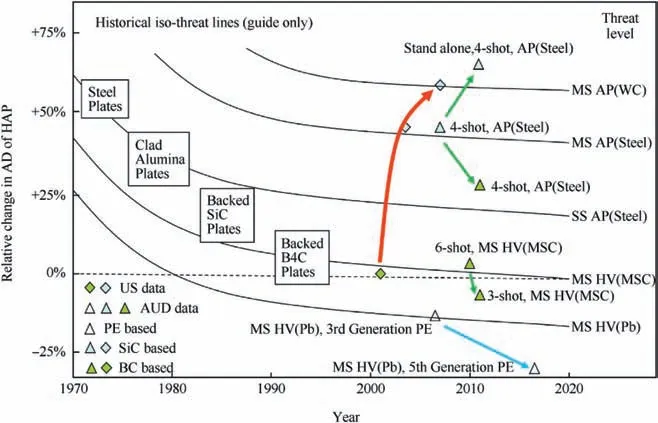
Fig.13. An historical chart showing the evolution of HAPs and, in particular, the effects that new materials, as well as threat level, have upon the areal density of the finished product. For reference, the SS AP(Steel) contour line is equivalent to the threat described in NIJ 0101.06 Level IV.
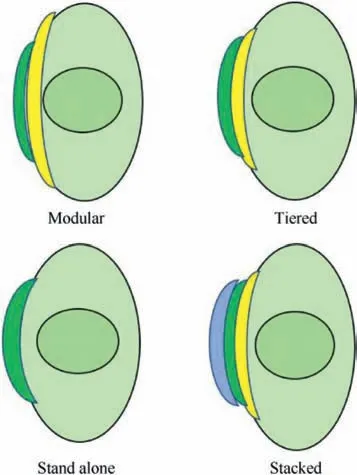
Fig. 14. A schematic, overhead view of the four different groups of Body Armour Systems.
6. Conclusions and final words
As the reader can now appreciate from this review,the evolution of new body armour systems is very dependent upon,not only new armour materials being developed but also, on the well-informed,and judiscous, use of strict, and evolving, design principles.
From this study,the following general conclusions can be made:
(1) Significant advances in materials will continue to enable the development of different body armour concepts, like the stacked systems currently available.It is strongly emphasised that these systems would not have been possible had it not been for the development of the latest generation of UHMWPE materials.
(2) The full gamut of body armour systems is now available to the civilian and military Users and it is definitely a case of horses for courses: i.e. operational requirements will continue to dictate which particular system is employed in the field, and the choice is now very wide.
(3) Lessons learnt from the consequences of a reduction in the size of the soft vests, without changing the size of the hard armour plate, should now be fully appreciated and more informed design-decisions made in the future.
(4) Material developments across fibres,fabrics,amd strike-face materials,will continue to refine,and improve,body armour systems but only in small, incremental steps.
(5) The perceived threat spectrum,as specified by the User,will continue to be the dominant factor in determing the overall weight of a body armour system
(6) There is now a very coherent drive in the development of smart textiles that will enable fabrics,especially those worm for uniforms, to be used for health monitoring, as well as increased levels of protection.
(7) The advent of stacked systems, introduces yet another interface within a body armour system, and a final word of caution is required. Controlling the quality, and magnitude,of interfaces, not only between the layers within a soft armour pack, and the gap between soft vest and the HAP, but now also between HAP1 and HAP2, is very crucial in guaranteeing the reproducible quality and ballistic performance of a body armour system - it is highly recommended,therefore,that more attention be given to this topic since it is not a trivial exercise.
Acknowledgements
I am eternally grateful to all of my colleagues,past and present,within the global armour community,especially those from the UK and Australia, and, in particular, my colleagues at the Defence Materials Technology Centre and Australian Defence Apparel during the period 2000 to 2015.
杂志排行
Defence Technology的其它文章
- Special materials in pyrotechnics VII: Pyrotechnics used in thermal batteries☆
- Real-time calculation of fragment velocity for cylindrical warheads
- Heavy metal free primers: Polymorphism of gadolinium and titanium in the context of GSR glass phase Felice Nunziata
- Mitigation of EDFA transient effects in variable duty cycle pulsed signals
- Ballistic impact properties of woven bamboo- woven E-glassunsaturated polyester hybrid composites
- Experimental investigations on wear properties of Palm kernel reinforced composites for brake pad applications
